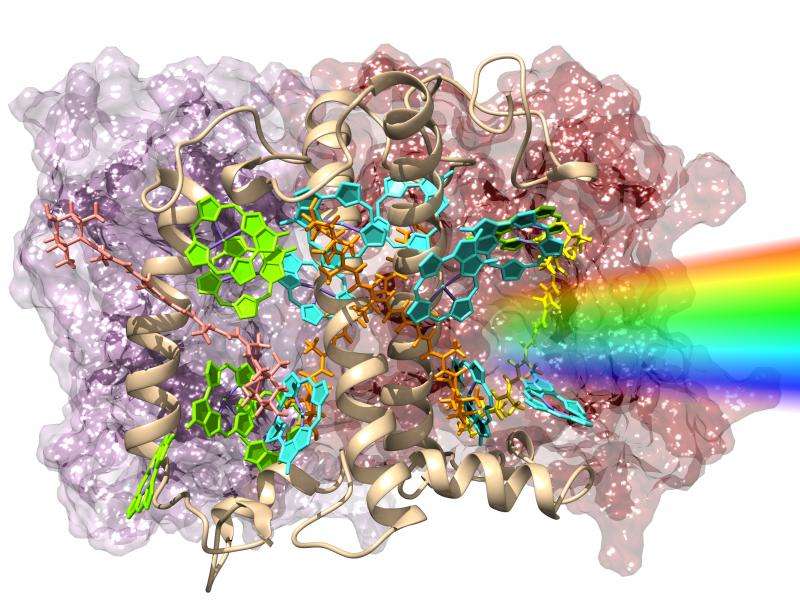Supercomputers enlisted to shed light on photosynthesis

Researchers at the UPV/EHU-University of the Basque Country are using high-performance computing to simulate the processes that take place during the first moments of photosynthesis
Using quantum mechanics as the basis, UPV/EHU computer scientists, physicists and chemists are working together to produce simulations of the molecule in which photosynthesis occurs. They have executed an Octopus software package in the fastest supercomputers in Europe, and after incorporating various improvements, they have carried out the biggest simulations made in this field by efficiently using thousands of processors.
Computing —the creation of supercomputers, above all— enables scientists and engineers to analyse highly complex physical processes using simulation techniques. In this case, researchers in the UPV/EHU's Department of Computer Architecture and Technology and the Department of Materials Physics are collaborating with researchers from various universities (including the Universidade de Coimbra, Universitat de Barcelona, Lawrence Livermore National Laboratory, Martin-Luther-Universität Halle-Wittenberg, University of Liege) to analyse the photosynthesis process basing themselves on various theories because the way in which plants absorb light remains a mystery.
The molecule that carries out photosynthesis in plants is the LHC-II (Light Harvesting Complex II), comprising over 17,000 atoms. Scientists do not know how this molecule acts when it receives photons of light. Complex computers and advanced programs are needed to be able to simulate molecules as big as this one. Joseba Alberdi, a UPV/EHU computer engineer, has written up his thesis in this field, thanks to the collaboration of the ALDAPA group of the Department of Computer Architecture and Technology of the Computing Faculty, and the Nano-Bio Spectroscopy group of the Faculty of Chemistry.
The aim: to achieve high performance
The Octopus software package used to make the calculations is underpinned by two theories which are the result of the reformulation of quantum mechanics and which are based on electronic density. With these two theories it has been possible to solve quantum mechanics problems using the computer; since "otherwise what you get are equations that are so complex that they are impossible to solve even with the most powerful supercomputers", explained Alberdi. "Unfortunately, very long execution times are needed to simulate systems in their actual size, and the only alternative is to use supercomputers," he added. In this work he has been able to use some of the world's fastest computers: the German Juqueen (with 458,752 processing cores), the Italian Fermi (with 163,840 cores), the German Hydra (65,320 cores) and the Catalan MareNostrum III (48,896 cores), among others.
The aim of this thesis by the researcher Joseba Alberdi was to optimize the Octopus code and to achieve high performance to be able to obtain the right acceleration factors in the calculations that are made in supercomputers. In fact, to be able to execute this code across multiple processors, it was necessary to sort out various problems affecting memory and performance. Fully executing the LHC-II molecule still poses a big challenge, but they have managed to simulate significant parts of the molecule. "We have simulated systems comprising 5,759, 4,050 and 6,075 atoms; according to the data we have available, they are the biggest simulations carried out so far," said the researcher. In these simulations they have been able to prove that the theory coincides with the reality. "These simulations will enable us to understand, for the first time, the reactions that occur during the first femtoseconds (10–15 s) of photosynthesis", he explained. At the same time, the improvements incorporated into the application make it possible to simulate many other systems of this size, and as it also involves free software, all physicists can avail themselves of it.
More information: "Insights into colour-tuning of chlorophyll optical response in green plants." Phys Chem Chem Phys. 2015 Aug 7. www.ncbi.nlm.nih.gov/pubmed/26250099
"Real-space grids and the Octopus code as tools for the development of new simulation approaches for electronic systems." arxiv.org/abs/1501.05654
"Computational Science and Its Applications" - ICCSA 2014. www.springer.com/us/book/9783319091525
Provided by University of the Basque Country



















